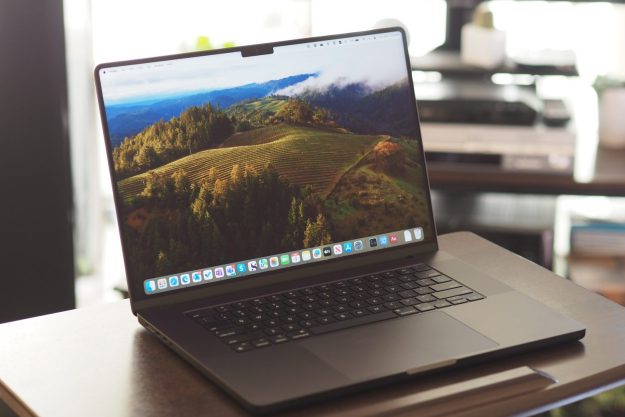Long gone are the days when Apple was the only company producing great-looking, powerful, midrange laptops. Today, it has many competitors, including the likes of Razer. But what if we pit the Razer Blade Stealth versus Apple’s MacBook Pro? Which is the better laptop for the money? Read on to find out.
Design

One of the biggest differences between midrange and entry-level laptops is that they tend to look a lot nicer and have much better features when they cross over the $1,000 line. That’s certainly the case with both the Razer Blade Stealth and the 13-inch MacBook Pro.
First, Razer’s laptop sports a sleek, aluminum exterior in an attractive, compact package that’s almost identical in size and weight to Apple’s MacBook Pro 13, although the MacBook Pro is a tad bit lighter.
Both devices sport acceptably-thick bezels. Those on the Razer Blade Stealth are far slimmer on the sides than the MacBook Pro, but its bottom bezel is much taller.
In terms of connectivity, there’s quite a stark difference between the two. The Razer Blade Stealth has a single USB-C port with Thunderbolt 3 and two USB-A ports. The MacBook Pro ditches legacy support and supplies either two or four USB-C ports with
On the keyboard front, the MacBook Pro provides one of the best we’ve seen on a laptop. That hasn’t always been the case, as Apple just upgraded the 13-inch MacBook Pro with its new Magic Keyboard in May 2020, which ditches the troublesome butterfly switches with those for a scissor design. Meanwhile, the RGB backlit keyboard on Razer’s unit is great for its target audience, who prefer a little color in their typing experience.
Finally, both
Performance

Despite the more mainstream marketing of the Razer Blade Stealth, its internal hardware is impressive. The cheapest model, costing $1,599, features a 10th-generation Core i7-1065G7 chip paired with Nvidia’s GeForce GTX 1650 Ti with Max-Q discrete GPU, 16GB of RAM, a 512GB solid-state drive, and a full HD screen at 60Hz.
If you want to get crazy, the top-end Razer Blade Stealth costs $1,999 and packs an 11th-gen Intel Core i7-1165G7, Nvidia’s GeForce GTX 1650 Ti with Max-Q discrete GPU, 16GB of
Here’s where things get a little weird with Apple. The company introduced its M1 chip in 2020, a new processor based on ARM’s CPU design. And because Apple is slowly showing Intel to the door, customers now have four MacBook Pro starting points: Two lower-priced units with the M1 chip and two higher-priced starting points with 10th-gen Intel chips.
The $1,299 entry-level 13-inch MacBook Pro has the Apple M1 processor, 8GB of
The thing to keep in mind is the target audience. The Razer Blade Stealth targets PC gamers who don’t necessarily want a gaming device, hence the discrete GPU and dark colors. Apple’s shiny MacBook Pro 13 targets professionals and doesn’t include a discrete GPU. Professionals who need a little extra graphical kick may want to consider the Blade Stealth or the
But, just for fun, let’s check out a few Geekbench scores:
| Single-core | Multi-core | |
| Core i7-1065G7 | 1280 | 2550 |
| Core i7-1068NG7* | 1342 | 4502 |
| Core i7-1165G7 | 1370 | 4127 |
| Apple M1* | 1738 | 7641 |
So, if we must compare apples (pros) to oranges (gamers), Apple’s M1 chip outperforms even the Intel chip offered in the 13-inch MacBook Pro. Where the Blade Stealth will clearly outshine is in graphics performance due to the GeForce GPU, which applies to gaming and other graphical-heavy software.
There’s no clear winner here. Again, each laptop targets a specific audience. Both are decent solutions if you’re shopping for a new laptop.
Portability

In a previous review of the MacBook Pro, we found one of its biggest disappointments to be the reduction in battery size over its predecessor. Cutting it back by almost 35% resulted in a drop in overall life, though it still managed more than 10 hours in our video loop test.
That changed with the M1 version of the MacBook Pro. In our most recent look, we discovered that the 58-watt battery provided one of the longest single-charge durations we’ve ever seen.
Why? Because ARM’s CPU core design targets high-performance while sipping the battery’s charge. That’s why ARM-based chips from Samsung and Qualcomm (and even Apple) are primarily used in smartphones and tablets. In light web browsing, the MacBook saw over 16 hours. When it was put through our video loop test, it reached over 21 hours!
In our review of the 2019 model, the Razer Blade Stealth only managed seven and a half hours in our video loop test and under five hours in our web browsing test. While it does have higher-powered hardware that no doubt contributes to the shorter battery life, the noticeable drop does make the Blade Stealth less useful when away from a charge point.
The portability of both
What’s more important, power or software?

As we state throughout the article, this is comparing apples to oranges. The MacBook Pro 13 targets professionals. The Razer Blade Stealth targets mostly gamers. The Blade would probably make a good Windows alternative for pros, but the Mac wouldn’t be an alternative mobile gaming PC unless you play Stadia or some other cloud gaming service.
However, when you examine and compare the base models, the MacBook Pro presently has a more reliable processor but lacks the discrete GeForce GPU. Neither laptop is the best choice if you’re using it for gaming, but the Blade has a greater potential of rendering a respectable frame rate. If you’re looking for something super stylish, we’d recommend buying an external GPU or looking somewhere else for a laptop.
In reality, none of that gaming nonsense truly matters if you just need a laptop for professional and personal purposes. The M1-based MacBook Pro is the obvious champion when looking at CPU performance, while the Stealth surpasses GPU performance. That being said, Intel/Nvidia combo can put some serious pressure on the battery, leading to poor performance when you compare it to the M1-based MacBook Pro.
The biggest question, then, comes down to the software. You must consider what you want to run. Outside the giant Windows versus MacOS debate, the Stealth earns the top spot thanks to the GPU when you’re analyzing graphics-heavy applications. The M1 version of the MacBook Pro runs conventional Intel-based software through an emulator, which could degrade performance despite the zippy chip. The Intel-based MacBook Pros, on the other hand, don’t require an emulator.
Editors' Recommendations
- Best refurbished MacBook deals: Get a MacBook Air for $140 and more
- Best laptop deals: Save on the Dell XPS 14, MacBook Pro 16 and more
- Best Apple deals: Save on AirPods, Apple Watch, iPad, MacBook
- iPad Pro M4 vs. MacBook Air M3: a harder choice than ever
- MacBook Pro OLED: Here’s everything we know so far



